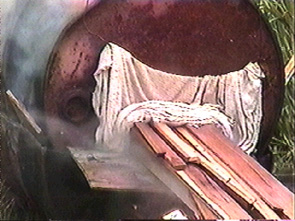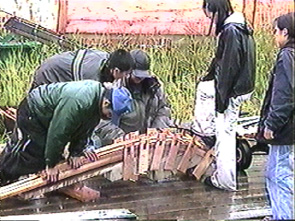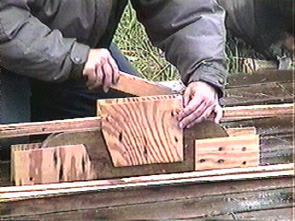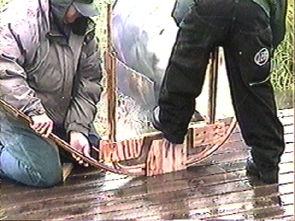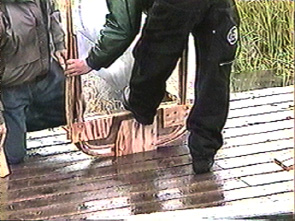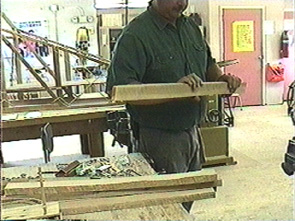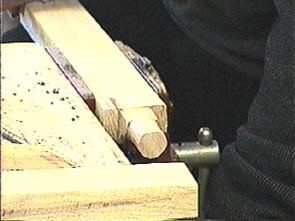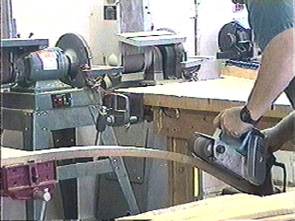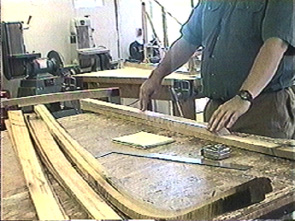|
Building a Dog Sled These instructions are based on a sled building project done as part of our vocational education program. We,I, made mistakes and I have tried to point out major flaws in these instructions so that it might save you from making the same blunders. How did I learn to build dog sleds? Well, I looked up stuff like this on the internet, talked to a neighbor who had helped build them in the past, looked at photos of different sleds, read a sled building booklet from the extension service, and looked at a couple of broken down sleds by my neigbor's house. Then I got some hardwood and gave it a try. It came out pretty good so the following semester we made one in shop class. The students were less than excited about making a dog sled, but I think it was still a worthwhile and interesting project and it made a lot of money for student activities when we raffled it. I have been using the first one I built with my two dogs and other than breaking my brush guard off during an early training run the sled seems to work fine. Of course I have nothing to compare it to never having stepped on any other dog sled. These instructions are for a tough, but flexable medium heavy duty sport-utility type sled. My finished sled weighs ???? (estimate 60 to 70 lbs). |
Step #1. We purchased a large rough-cut 2x10x16' hickory board. It was very expensive ($178.36). I understand that ash is better and birch is just as good and oak works too. I tried making my own birch board from a birch tree, but it is a long hard ride to the trees from Nunap and all I could find were crooked and knoty. There was a lot left over from the board and, I beleive, a ten footer would be enough if I were extra careful with the planning and cutting. Cut out the following pieces from your board; Two 2"x1"x8 ft. for runners. Two 1"x1"x8 ft. for the rails. A little less than 1" thick is OK. Seven 1/4" to 3/8" by 2" by 8 ft. slats for the bed of the sled. Four or five very thin (less than 1/4" ) strips about 6 feet long and 3/4" wide for the handle bar (to be laminated). These are all the parts that need to be bent. You need a steamer and a bender before going on to the next step. |
|
|
|
|
Above: Photos of us steaming the sled parts. Step #2 (steaming) I fashioned a simple steamer from two old rusty barrels. As can be seen in the photos above I cut one in half length wise and cut rectangular holes in the ends of another. (Make sure there is no flammable fumes in the barrel before cutting - jig saw works, torch is faster). I got the idea from "Building a Dogsled" by Marsha Million (Circumpolar Press, Anchorage, AK). I am sure there are some much better steamer designs available, but this is what I had. The lower half barrel is for the fire and has a hole on the end to push firewood into. the upper barrel is filled with water up to the edge of the rectangular holes. When the water is boiling I put the pieces to be bent through the rectangular holes so that the sections to be bent are inside the steamer and cover the holes with rags to hold the steam in. It took about four hours before I could bend the wood without hearing it crack. A couple of the handle bar peices cracked because they have such a tight bend. That is why I recomended in step #1 cutting a couple more than you will probably use. |
Step #3 (bending) Build benders for the runners, rails, slats and hanlebar using whatever boards you have around. I tried to take a short cut and build a wide bender to put all the runners and rails and slats on together and another for the handlebar. That was a mistake, next time I will make two binders -- one for each runner. The curve of the bender should be a few inches steeper than you want the runners to bend because they tend to relax or streighten a little after being removed from the bender even if they are completely dry. A 12 to 15 inch rise in front should be good for most sleds. I blocked the runners into place on the bender first and then bent the slats and rails all together over the runners because these parts do not need to be bent as much as the runners. The handle bar needs two 90 degree bends and I found this to be impossible except with very thin and well steamed strips. I bend several thin strips together. Some break as I block them in place, but enough do not break. The good ones will be laminated together with wood glue to make the handle bar about a half inch thick. The width of the handle bar bender should match the outside width of the sled. I made mine 21 inches. |
|
|
|
|
|
|
|
The above four photos show us bending and blocking and tieing parts to our benders. Step #4: Next, while the bent parts are left in the corner of the warm shop to dry for a couple of weeks we go on to prepare the other parts. Many parts are cut oversize a little to be cut off flush later. I will use the measurments for my sled here, but make adjustments to suit yourself. Stanchions: Need six (3 pair) of these cut 2 inches wide by 1 inch thick and cut a little longer than necessary. One pair should be about 36 inches long, the second pair about 27 inches long, and the third pair only 18 inches long. Cross-pieces: Need four 1 inch by 1 inch by 21 inches (width of sled) Front Cross-piece: Need one wedge shaped cross piece 20 1/2 inches long by 2 inches wide. One side should be 3/4 to 1 inch thick while the other side is a little under 1/4 inch thick. False runners: Need two of these 2 inches by 1 inch by 4 feet long. I was thinking I would make my next one closer to 5 feet long for the added strength. Cut the front of the false runners at an angle to make it look better. |
Step #5: You still need to cut the braces, but those can be done later. Round off the bottom 3 inches of the two longer pairs of stantions and the bottom 2 inches of the short pair. The longer pairs need to fit through the false runners and the runners while the short pair only has to fit through the runners. They need to be rounded to fit tightly into a 1 inch hole. I did this by cutting the edges with a band saw and then rounding them off with a large belt sander. I bet a lathe would work better. Extra Note: On my first sled I made squre holes and trimmed part of the stantion to fit in the hole. I had much difficulty making the square holes and even more trouble getting the recommended tight fit. Please remember that I am not a professional shop teacher -- the only time I ever had wood shop in school was when I was in the seventh grade. Anyway, I have decided that it is easier to make a round hole and round off the stantions. At least until I learn some new wood working techniques. While you are working with the stantions go ahead and sand off all the sharp edges and sand the sides smooth. I used a belt sander with a fine grain sand paper to make it look good in a relatively short time. |
|
|
|
|
Above: Cutting pieces for the stantions. My first sled is in the background being used as a model. Below: Sanding the parts with a belt sander. |
Above: Rounding the ends of the stantions so that they will fit tightly into a one inch diameter hole. Below: Start assembly by attaching false runners. |
|
|
|
|
Step #6: When the runners have had a couple of weeks on the benders then take them out and sand them smooth. I do not recommend rounding the edges of the runners or false runners, but rounding the edges of all the other parts is a good idea, I've been told, to help prevent cutting and tearing of clothes and flesh in case of a crash. The false runners should already be sanded. PS. The "false runner" is the peice of wood that is about half to two thirds the length of the runners and is bolted directly onto the runners. Foot pads will be added to the false runners to give you something with traction to stand on.
Need eight 3/8" by about 4" bolts with smooth heads and washers/nuts. |
Step #7: Place the false runner on the runner, line up the back edges flush and decide where to drill three holes to bolt it down. You want at least 24 inches sticking out behind the rear stantions. On my next sled I am going to leave 30 inches sticking out to stand on to make it a little more comfortable. Use a pencil to mark exactly where each stantion will go so that you do not place a bolt where you will want to put a stantion later. The small stantions should go on the front just a couple of inches up the curve (they will angle back a little). Once you have decided where to put the rear and front stantions then put the middle stantions a close as possible to half-way. The middle stantions should also fit into the false runner just like the rear stantions. I put one bolt as near the front of the false runner as possible, one between the stantions about half way and the third near the back end of the runners. |
|
|
|
|

